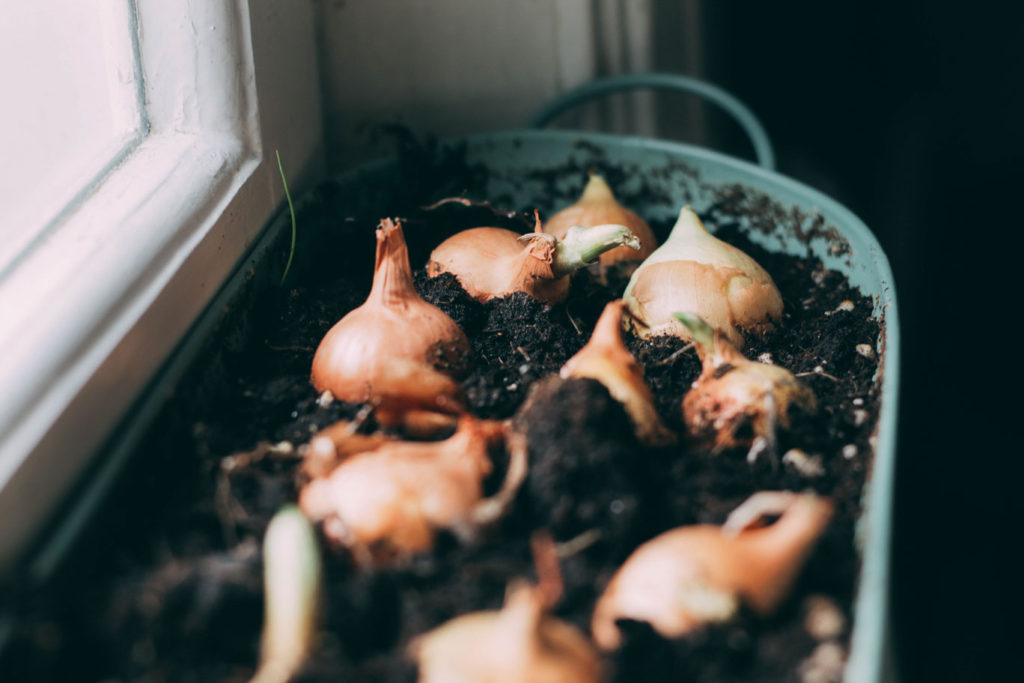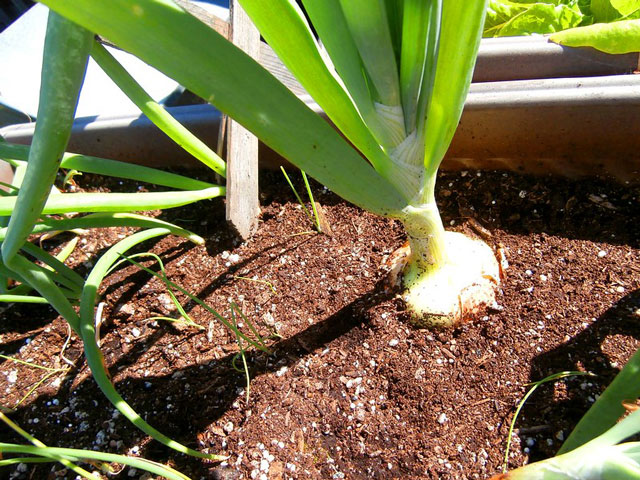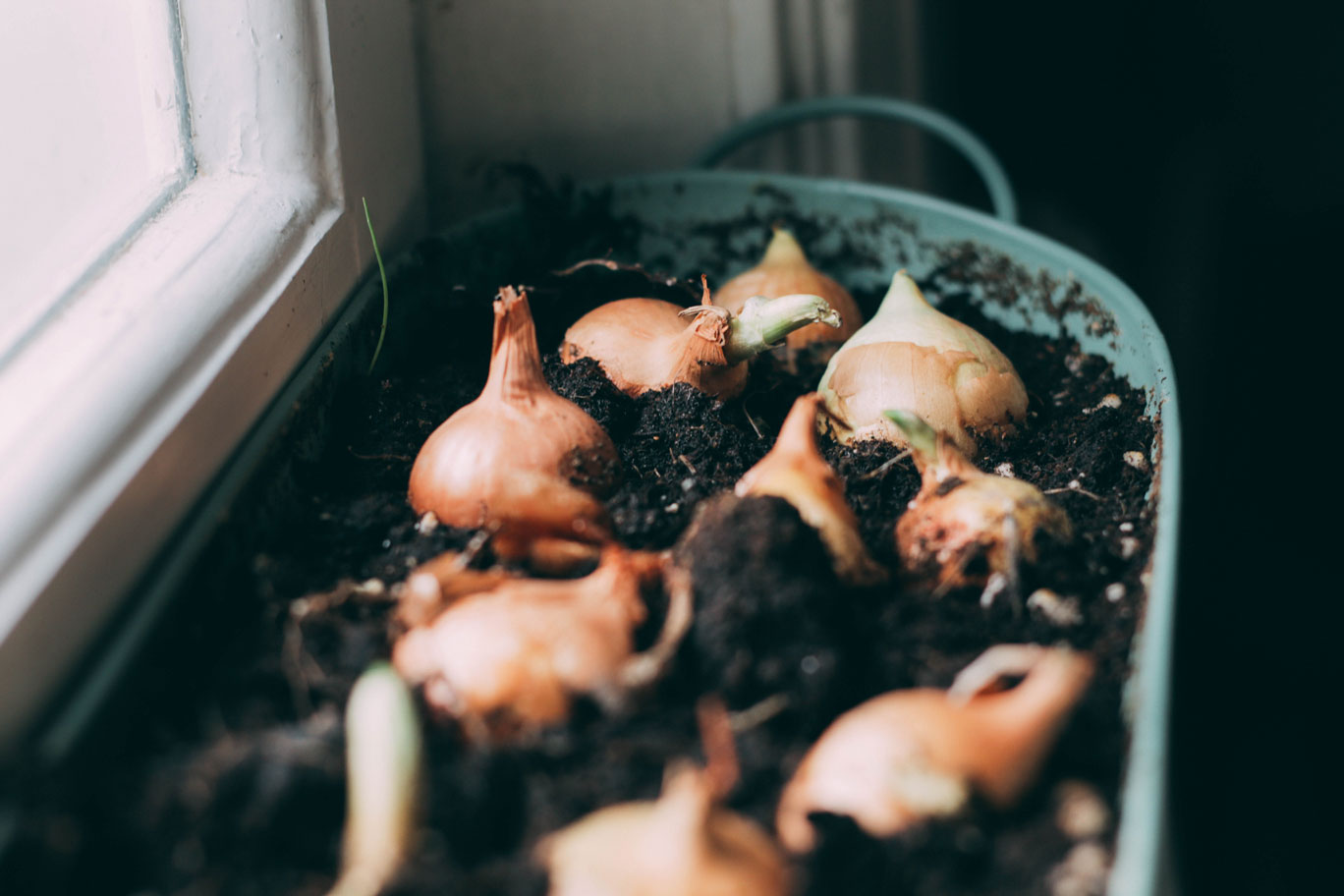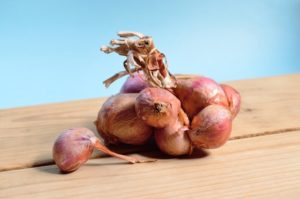It’s no secret that onions should always be part of your pantry. It is a very versatile ingredient that is welcome in every kitchen. From breakfast to dinner, onions can make or break a meal. You can’t deny that onion is one of the most important ingredients to ever grace the kitchen. Let’s see how to grow onions, yes you can grow it.

I mean, you can drown in recipes with onions as one of its ingredients. It’s that vital in cooking. And when it comes to health benefits, it’s proving to be worthy too.
Just to mention a few; it’s packed with vitamins like vitamin B1, B6 and C. It also contains high amounts of folic acid, fiber, chromium, and calcium. The antioxidants found in onions can also boost your immune system.
Did I mention that it’s also good for the heart? It’s been shown to lower blood pressure and cholesterol.
Onions come in many varieties but one thing can be said for all: they are all easy to grow! Home gardeners will have a good time planting and growing this one. Just imagine how much more delicious your meals will taste with fresh home-grown onions.
I’m very excited to share with you all you need to know about growing onions in containers at home. Get ready for your very own supply of fresh onions!
Growing Onions
Difficulty Level, Maintenance, And Other Advantages
Before anything else, there’s one thing you need to know about growing onions.
This cold-season crop is very easy to grow! So just relax. You’re gonna have a great time growing onions on your own. Oh, and did I mention this plant requires very little cultivation? Compared to other vegetables, garlic plants are low-maintenance.
It’s a quick and simple plant to grow—the perfect starter vegetable for any budding gardeners out there. Look, even if you don’t have your garden established yet, this crop can perfectly grow indoors in pots! I can safely say that the difficulty level for this one is easy.
All you need is some fertile soil and a spot with a decent sunlight and you’re good to go! I’ll handle the rest, so just continue reading.
So ready your gardening tools because today you will learn how to grow onions on your own. And with proper guidance, I guarantee that you’ll harvest some good home-grown onions in the end.
How to Plant Onions – All You Need to Know
When is the best time to plant onions?
You probably already have your tools and gears ready but before you start digging the dirt you should check your calendar first.
Not all crops can grow year-round. You need to know when is the best time to plant your onions.
This cool-season crop is best planted in spring (Feb to April) or late autumn. You can plant onions as soon as the ground is workable. Gardeners may plant as early as 4 weeks before the first frost-free days.
Just make sure outdoor temperatures don’t go below 20°F (-6°C).
Should I use onion seeds, transplants or sets?
Now that we’ve got that covered, let’s see what’s the best way to start an onion plant.
There are three ways to plant onions at home: by seeds, transplants, or sets. Among these three,
I highly suggest you use onion sets for planting your onions.
First of all, using onion sets is the easiest among the 3 planting techniques. So good news for all the beginner gardeners out there. It also produces the earliest onion – ahead of the seed-started ones.
Not to mention, it has the highest success rate among the three!
By using onion sets, you no longer have to worry about frost damage either. Also, using onion sets to grow onions saves a lot of time! You can save up to sixty days of gardening depending on the variety. Perfect for those who live in regions with a short growing season.
Lastly, I like using onion sets because it just yields a lot of large onions perfect for storage.
What is the best container to use when planting onions?
In this plant project, we will be using onion sets. These onion plants can thrive well in raised beds. Raised rows that are at least 4 inches high also works well.
If you don’t have a raised bed, you’re someone living in the city or simply have limited space available for gardening, no worries! Onions can grow perfectly well in large mouthed pots that are at least 10 inches deep.
When I say large-mouthed pots, it should be several feet wide. You would want to be able to plant as many onions as possible to make it really worth your time. Plastic tubs are cheap and durable.
There are many options available on Amazon but check your local nursery first, they might just give you one for free as they usually dispose of some of them at the end of every season.
A 5-gallon bucket can also do the trick if you have one around.
However, you may only be able to grow 3 or 4 onions per bucket. Onions need at least 3 inches of open soil around them to grow properly.
Remember to put holes at the bottom of your containers for drainage.
How do I prepare the soil for planting onions?
Onions work best in loose and well-drained soil. Properly prepared soil will allow your onions to grow bigger and tastier bulbs so do not skip this step. Use nitrogen-rich soil mixed with multi-purpose compost.
The soil should also be slightly acidic with a pH of 5.5 to 6.5.
After making sure that your soil has the qualities that I’ve mentioned above, here are some guidelines to follow:
- In early spring, loosen the soil with a rake or with your hands
- Remove and weeds or rocks on your planting site
- Work in the aged manure into the soil or mix in half to a full bag of organic compost
- Add any commercial fertilizer, onions are heavy feeders (just follow the instructions on the packet)
- Loosen and rake the soil
- Flatten down the soil, make it firm
Again, a well-prepared soil is vital to the healthy growth of your plant so make sure you give proper attention to this step.
How do I plant onions?
After preparing the soil, it’s time to plant the onion sets. If you’re using a raised bed or planting direct to the garden ground, follow these steps.
- Pick out the larger and harder onion sets (no larger than a dime), they’re the best ones to grow
- Using a long piece of string, make a straight line
- Using your garden trowel or any garden digging tool, space holes 4 to 5 inches apart
- Dig holes about 1 inch deep
- Make rows 12 to 18 inches apart
- Place the onion sets (make sure they’re pointing upwards)
- Add mulch between the rows of onions to help retain moisture and to stop weeds from forming
- Cover the holes and water them

If you’re planting the onion sets in containers, follow these steps:
- Pick out the larger and harder onion sets (no larger than a dime), they’re the best ones to grow
- Using your hands, dig holes about 1 inch deep
- Wait for the soil temperature to reach about 60 degrees
- Place onion sets and space them at least 3 inches apart from each other, give them plenty of room to grow
- Cover the holes and water them
Congratulations! You’re done with the planting part, you just have to wait for it to mature.
Growing Onions
How and when do I thin my onion plant?
Since we are using onion sets, you wouldn’t be needing to thin your onion plants as they wouldn’t be overcrowded and they are past their seedling stage.
How can I properly water my onion plant?
For ground-grown onions, consistent watering is needed if you used mulch. Just about one inch of water per week is going to be sufficient (this includes rainwater). You can water more if you want sweeter onions but careful not to overwater them.
Make sure the soil is evenly moist and not wet or soggy.
For container-grown onions like the pot ones, watering them is very important. Pot-grown onions have little access to naturally stored rainfall found in ground soil, unlike the ground-grown ones. Onions grown in pots will need at least 2 – 3 inches of water per week.
Adjust and increase the amount of water in hot weather and in drought conditions.
Gardening tip! If the top of your soil is dry to the touch, it’s time to give them some water. Make sure to check your onions daily.
Which fertilizer should I use and when do I use it?
If you’ve followed the soil preparation guidelines above, then I expect that you are already using a fertile soil. The organic matter you’ve worked into the soil before planting will work wonders for the onions.
You only need to fertilize your plants every three to four weeks with nitrogen or vegetable feed to get bigger bulbs.
Stop fertilizing when you see the onions push the soil away and the bulbing process has started.
Bulbs will and need to emerge above the soil. This is normal. Do not put the soil back around them.
How much sun does my onion plant need?
Whether you’re growing onions in a raised bed or in pots, it’s essential that you choose a location that gets twelve to fourteen hours of sunlight per day. Onions need full sun to thrive, make sure it is not shaded by other plants.
Which climate better suits onions? (Best Hardiness Zones)
Onions are a very temperate crop. Typically, they can thrive in most climates. There are three categories of onions based on the sunlight they need. Short-day onions are better for warm climates since they only need 10-12 hours of daylight.
They’re perfect for those living in the southern region.
Long-day onions require 13-14 hours of daylight. They are grown in the northern regions with a USDA of zone 6 or colder.
During the fall season, day-neutral onions can thrive in cool mild winter climates. They are deal for USDA zones 5-6 and need 12-14 hours of sunlight.
Varieties that fall under the day-neutral category typically tastes super sweet! All in all, onions are generally suitable for the U.S. Department of Agriculture hardiness zones 3 through 9.
How long does it take to grow onions and what should I expect in each growing stage?
Since we planted onion using onion sets, you will only need to wait a shorter time for harvest. We’ve saved up to 60 days worth of gardening (depending on the variety). We’ve skipped the earlier growth stages like the germination and seedling formation.
You’ll only be needing at least two months for the onions to mature. During this period, expect the onions to continue to bulge until it reaches above the soil.
What are the common diseases and pests that could ruin my onion plant and how do I avoid it?
Watching your onion plants maturing, I understand that you might worry about the pests or other diseases that might attack your plant.
However, onions are typically a disease-and-pest-free crop, so no need to worry.
But I’ve listed down some of the problems you might encounter down below and how you can deal with them, just to be sure:
- Onion maggots
These pests like to lay its eggs at the base of the plants. Prevent this by covering your emerging onion bulbs with a fine mesh netting. Seal around the edges by mounding it with soil.
Keep your garden clean and pick out the decaying organic matter as they attract these insects. You can expect Onion maggots during very rainy periods, so you can disregard these suggestions during dry seasons.
Remember to completely harvest your onions as the season progresses. - Downy mildew
You can spot this disease when you observe yellow spots on leaf surfaces and patches of mold on the underside. This nasty disease favors cool humid conditions. Avoid this disease by planting resistant cultivars.
Prevent spreading by removing the affected leaves and stems. - Thrips
Thrips are tiny insects that can attack your plant. They look as fat as a sewing needle. They’re very tiny so in order to check if they’re around your crops, knock a dark piece of against onion tops. They will appear as tan-colored bodies on the paper.
Follow the package directions of your insecticidal soap spray and they will disappear after a couple of treatments. - Onion neck rot
Caused by the fungus Botrytis allii, onion neck rot appears as a grey-colored fluffy fungus growing on the head of the onion that into a black fungus after some time. Do not plant your onions in the same spot every year consecutively in order to avoid this.
Plant other crops instead.
To all nervous gardeners reading this, especially the beginners, I suggest you calm down. Even I had my own share of panicking when I just started gardening. Gardening mishaps is like a rite of passage. Learn from your mistakes and become a better gardener.
Most importantly, I’ve learned that no matter how big or small the problem is, I know my fellow gardeners are always ready for a solution and suggestions! Don’t be a stranger and mingle with the online gardening community.
What other crops could I plant together with my onions to maximize my garden space?
If you’re just a beginner who dreams of starting a full vegetable garden, you should be familiar with companion planting.
What is companion planting? Simple, it’s a form of polyculture used by fellow gardeners and farmers that is believed to produce mutual benefits for certain plants and crops planted next to each other.
Basically, the idea is by planting these companion plants, the crops can help each other grow healthily. To list some of the benefits: natural pest control, higher crop yield and shade protection for sun-sensitive plants.
All these benefits while maximizing your garden space! Truly perfect for those with limited garden area.
Onion is one of the best companion plants for other crops because they have the natural ability to deter bugs.
Here are some of the pests that onions can keep away from your precious crops: cabbage loopers, aphids, cabbage worms, cabbage maggots, and Japanese beetles.
Onions are really good companion plants for the cabbage family plants!
Onion plants can also keep away carrot flies from your carrot crops. These two also work well together.
Here are some of the best companion plants for onions:
- Cabbage
- Carrots
- Broccoli
- Peppers
- Strawberries
- Lettuce
- Tomatoes
- Brussel Sprouts
Read more how-to-grow articles on this site, I have so many more gardening stories to share so you can add more crops to your garden!
What are the crops that will not go well with onions?
While we can see that the onion has a great number of companion plants that we should be thankful for, there are just some plants and crops that will never go well with this vegetable.
Did you know that other onion plants are bad neighbors for your onions? You need to scatter your onion plants in your garden so the onion maggots wouldn’t be able to travel easily and treat your crops as an open buffet.
Here are some of the onion’s bad neighbors:
- Peas
- Beans
- Sage
- Asparagus
Harvesting Onions, When?
You’ve finally reached the harvesting stage!
It’s time to congratulate yourself for all the hard work you’ve put on. Time to taste the fruit of your labor but how do you know when your onions are ready to be harvested?
If you planted your onions early in the spring you can typically harvest by fall. You can tell when your onions are ready for harvest when onion tops and stems have turned yellow. The stems will also fall over.
You can also a rake to bend them over horizontally to stop that sap from flowing to the stems. By doing so, you encourage the plant to put its energy into maturing the bulb.
In just a day or so, when the tops finally turn brown, pull or dig the bulbs. Do this on a sunny day because you need to leave the bulbs to dry in the sun.
Gardening tip! Prevent sunscald by laying the onion tops of one row over the bulbs of the other row.
Check if the outer skins are completely dry. Wipe off any soil and remove the tops. You can leave them be if you intend to braid them, though I’ll leave that to the more advanced gardeners. Out there.
How to harvest onions?
Loosen the soil around the bulbs so it can start drying. When the onion tops are brown and the stems bent over, pull the onions. Clip the onion roots and cut the onion tops back to 1 inch. If you know how to braid them, leave them be.
Cure and dry them for several weeks before storing them.
What is the best way to store the onions that I have harvested?
You can store your harvested onions in any cool, dry place. For the advanced gardeners, just hang your braided onions or keep them in mesh bags or nylon stockings in any airy spot. Make sure you store at 40 to 50°F (4 to 10°C).
These onions are long-lasting. Expect dried bulbs to keep for about 4 months to 1 year. You can definitely enjoy your yield almost year-round!
I strongly advise you not to store onions with fruits like apples or pears. The ethylene gas produced by the fruits will have an effect on your onions’ dormancy. Another thing, onions may also spoil the flavor of these fruits so it’s really a bad idea to store these together.
You should also use or eat the sweeter varieties of onions first before going in on the pungent ones. The pungent onions will store longer than the sweet onions.
Enjoy your harvest and join me again next time for another gardening session!
Featured Table
| Botanical Name | Allium cepa |
| Plant Type | Vegetable |
| Sun Exposure | Full Sun |
| Soil Type | Any, Loamy |
| Soil pH | Neutral |
| Bloom Time | |
| Flower Color | |
| Hardiness Zones | 3, 4, 5, 6, 7, 8, 9 |



